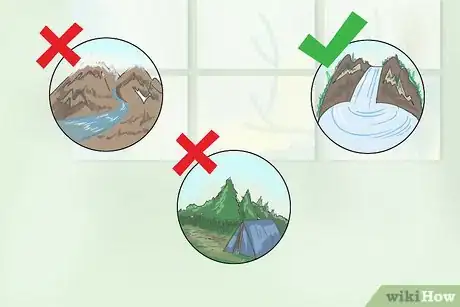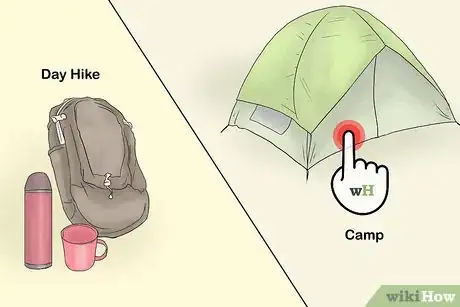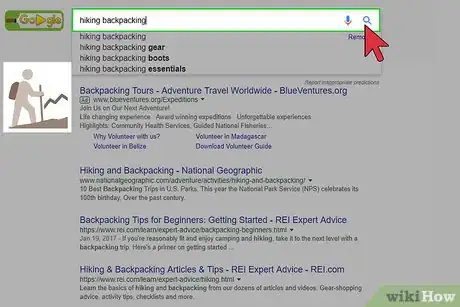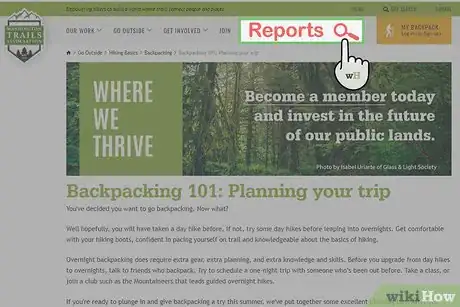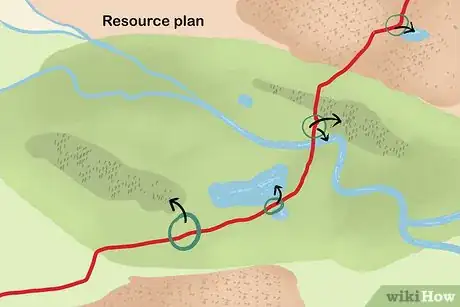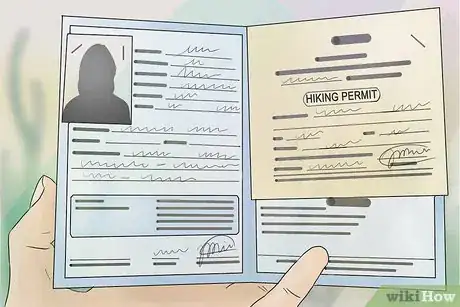This article was co-authored by Halle Payne. Halle Payne has been hiking and backpacking in Northern California for over 3 years. She was Trip Leader for Stanford University’s Outdoor Education Program, Hiking Leader for Stanford Sierra Conference Center, and has taught classes in Outdoor Education and Leave No Trace principles.
There are 8 references cited in this article, which can be found at the bottom of the page.
This article has been viewed 4,196 times.
A hiking vacation can offer fresh air, pristine scenery, and great exercise. To choose the best destination, first decide what kind of sights and environments you’d like to see, like waterfalls or mountains. Figure out whether you want to stay local or spend money on long distance travel. Look for trails and parks online using search engines, websites of hiking associations and organizations, and national or state park services. To narrow your list, research trip reports and find out trails’ difficulty levels to find one that matches your abilities.
Steps
Finding Desirable Trails
-
1Choose the type of scenery you’d like to see. From waterfalls to sprawling stretches of forest, a hike can offer a range of gorgeous vistas. Think about the natural beauties that appeal to you and include them in your search queries when you look for trails.[1]
- For example, if you want to find a location that offers endless views, look for a hiking trail that increases in elevation and culminates at the top of a hill or mountain.
-
2Keep your budget in mind. As you consider the scenery and environments you’re interested in, look for spots that you can travel to affordably. You’ll have more options available if you can afford to travel long distance but, even on a budget, you’ll be able to track down an appealing destination closer to home.
- While you might not be able to find a nearby tropical forest trail if you live in a temperate environment, chances are you’ll be able to track down an awe-inspiring vacation destination without having to spend lots of money on long-distance travel.
-
3Decide if you want to day hike or camp. If you’re a beginner, it’s best to stick to day hiking, so look for a nearby hotel or cabin and, if necessary, a car rental agency. If you’re more experienced, look for backpacking trails that have resources like fresh water and suitable campsites.[2]
- If you plan on camping overnight, you’ll most likely need to acquire a permit and register with the local park service.[3]
- Park or trail websites will include maps that note resources for camping and any applicable registration procedures.
-
4Search online for trails. After getting a general idea of the types of environments and trails that appeal to you, look for a match online. The easiest way is to enter your location (or a location where you’d like to travel) and keywords like "hiking" and "backpacking" into a search engine. Include terms like waterfall, mountains, old growth forest, and other environmental characteristics in your search.[4]
-
5Look for trip reports and reviews. Once you’ve put together a list of potential trails, try to find out what other hikers have said about their experiences. Search for a local hiking association or organization with trip reports, and check Google for reviews.[8]
- For example, if you’re thinking about visiting a hiking trail in Washington, U.S., search the Washington Trails Association website for a trip report.
- While you can usually find good recent photographs on Google listings, take the reviews with a grain of salt. Remember that any positive or negative online review might be biased. A report by an experienced hiker on a hiking association or organization website will most likely provide more credible information.
Evaluating Difficulty
-
1Choose easy class 1 or 2 trails if you’re a beginner. Your level of experience is an essential consideration when choosing a hiking destination. Easy trails are well-maintained with little elevation, moderate trails have steady ascents with some roots and other obstacles, and strenuous trails have steep ascents and frequent obstacles.[9]
- Trails are often rated on a scale of 1 to 5, with class 1 being easy hiking with minimal elevation and class 5 being advanced-level rock climbing.
- Check potential trails’ ratings and avoid choosing a trail that’s beyond your experience level.
-
2Map your route’s length according to your experience. If you’re just starting out, a 5-mile (8 kilometer) round trip hike is a good maximum distance. Use a potential trail’s map to plan out your day hike or, if you’re more experienced, your multi-day backpacking trip.[10]
- While the range you can cover per hour will depend on trail difficulty, an average rate is about 1.5 miles (about 2.5 kilometers) per hour. When you plan your trip, make sure you have enough time to complete your hike before sunset.
-
3Take your kids and pets into account. If you’re planning a trip with your family, look for a trail that’s easy enough for the youngest child joining you. Search for kid-friendly trails around the travel location you’ve chosen.[11]
- If you want to hike with your dog, it’s best to avoid climbing trails with steep inclines that require opposable thumbs.
- When hiking in groups, remember that a trail’s difficulty level should always match the least experienced hiker’s abilities.[12]
Planning Your Hiking Trip
-
1Identify your route’s resources if you’re backpacking. While you should always check out your trail’s map before starting your hike, studying your route is even more essential when backpacking. Look for spots where you can refill your water supply and clearings where you can set up camp.[13]
- Be sure to give yourself plenty of time to reach a prospective campsite before it gets dark.
- Check the websites of the park service or local hiking associations for topographical maps. If you know your route’s elevation in advance, you’ll be able to pace your hike accordingly.
-
2Figure out if you need any passes or permits. Most overnight trips will require registration with the local park office or ranger. If you plan on parking your car during a day hike, you might need to get a parking pass to avoid getting a ticket.[14]
- The park or trail website will list information about parking, permits, and registration requirements.
-
3Check your destination’s sunset times. You’ll need to familiarize yourself with local daylight hours, whether you’re planning a day hike or an overnight camping trip. Look online for sunset times during the days you’re planning your vacation. Always make sure you give yourself plenty of time to finish your hike or reach your campsite before it gets dark.[15]
-
4Check the local weather forecast. When choosing your vacation spot, keep the local climate in mind. While you won’t know exactly what the weather will be far in advance, knowing your destination’s climate will give you the best shot at avoiding undesirable weather. As your vacation approaches, check your hiking destination’s local weather so you can pack appropriate attire and gear.[16]
-
5Ask the ranger’s station or park office about warnings or closures. When you narrow down your list of potential destinations, call local park rangers or offices and ask about temporary or long-term hazards and closures. Just before your trip, call them again to check in about any local conditions or advisements that could impact your hiking vacation.[17]
- For example, wildfires or downed trees can shut down trails for anywhere from a few days to many months.
-
6Give your travel plan to someone back in civilization. Before you leave for your hiking vacation, make sure you inform a friend or family member about your travel plans. Let them know where you plan to be on each day of your vacation. If you’re backpacking, give them your planned campsites locations and let them know when you plan on setting up and breaking down each camp.[18]
- If possible, especially you’re a beginner, try to check in with someone regularly during your trip.
Expert Q&A
-
QuestionHow do I plan a hiking route?
 Halle PayneHalle Payne has been hiking and backpacking in Northern California for over 3 years. She was Trip Leader for Stanford University’s Outdoor Education Program, Hiking Leader for Stanford Sierra Conference Center, and has taught classes in Outdoor Education and Leave No Trace principles.
Halle PayneHalle Payne has been hiking and backpacking in Northern California for over 3 years. She was Trip Leader for Stanford University’s Outdoor Education Program, Hiking Leader for Stanford Sierra Conference Center, and has taught classes in Outdoor Education and Leave No Trace principles.
Hiking & Backpacking Trip Leader Check online first. The great thing about camping and backpacking these days is someone on the internet has already done the trails you're thinking about doing, and will have a full report online. Try a site like the Outbound Collective, and look up the trail you're considering. If backpacking is new to you, you want to know that the trails are well marked and easy to follow. You'll also want to read about where people filled up on water, what permits you'll need, and how many days it takes to do a certain trip.
Check online first. The great thing about camping and backpacking these days is someone on the internet has already done the trails you're thinking about doing, and will have a full report online. Try a site like the Outbound Collective, and look up the trail you're considering. If backpacking is new to you, you want to know that the trails are well marked and easy to follow. You'll also want to read about where people filled up on water, what permits you'll need, and how many days it takes to do a certain trip.
References
- ↑ https://www.nps.gov/grsm/planyourvisit/hiking.htm
- ↑ http://www.wta.org/go-outside/basics/backpacking/backpacking-101-planning-your-trip
- ↑ https://www.nps.gov/grsm/planyourvisit/hiking.htm
- ↑ https://www.nps.gov/grsm/planyourvisit/hiking.htm
- ↑ https://americanhiking.org/
- ↑ https://www.nps.gov/index.htm
- ↑ http://www.trails.com/
- ↑ http://www.wta.org/go-outside/basics/backpacking/backpacking-101-planning-your-trip
- ↑ http://www.active.com/outdoors/articles/how-to-choose-the-right-hike
- ↑ https://www.nps.gov/grsm/planyourvisit/hiking.htm
- ↑ https://www.nps.gov/grsm/planyourvisit/hiking.htm
- ↑ https://americanhiking.org/resources/planning-your-hike/
- ↑ http://www.thehikinglife.com/how-to/planning/
- ↑ http://www.wta.org/go-outside/basics/backpacking/backpacking-101-planning-your-trip
- ↑ https://www.nps.gov/grsm/planyourvisit/hiking.htm
- ↑ https://americanhiking.org/resources/planning-your-hike/
- ↑ http://www.wta.org/go-outside/basics/backpacking/backpacking-101-planning-your-trip
- ↑ https://americanhiking.org/resources/planning-your-hike/
